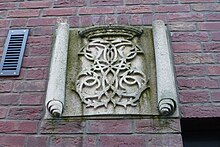Joh. Enschedé
 | |
| Company type | Private company |
|---|---|
| Industry | Printing |
| Founded | Haarlem, 1703 |
| Founder | Izaak Enschedé |
| Headquarters | Haarlem, Netherlands |
Number of locations | Haarlem, Amsterdam and Brussels |
Area served | European Community |
Key people | Arie Piet, Chief Executive Officer |
| Products | Security documents, banknotes, stamps |
| Services | Design, print |
| Revenue | €60 million |
Number of employees | 450 |
| Website | www.joh-enschede.nl |
Royal Joh. Enschedé (Dutch: Koninklijke Joh. Enschedé) is a printer of security documents, stamps and banknotes based in Haarlem, Netherlands. Joh. Enschedé specialises in print, media & security. The company hosts the Museum Enschedé and has branches in Amsterdam, Brussels and Haarlem.
History
The company was founded in 1703, when Izaak Enschedé registered with the Printers Guild in Haarlem.[1]
Joh. Enschedé has long been associated with the printing of banknotes; the company printed the "Robin", the very first Dutch banknote, in 1814. Since then, Joh. Enschedé has printed the banknotes of the State of the Netherlands. In 1866, Joh. Enschedé began printing stamps.[1]
Typefounding
Enschedé began manufacturing type in 1743 after purchasing the foundry of Hendrik Wetstein, and the foundry soon became the most important part of Enschedé’s business. The famous punch-cutter Joan Michael Fleischman was employed there in the eighteenth century. Its type business flourished throughout the eighteenth and nineteenth centuries, and in the twentieth century the foundry achieved widespread international acclaim through the design and production of types of Jan van Krimpen. During the foundry type era, Enschedé types were distributed in the United States by Continental Type Founders Association.
Foundry Type Faces
These foundry types were produced by Enschedér[2]:
Anniversaries
In 1978, to celebrate their 275th anniversary, Enschedé commissioned Bram de Does, one of Holland’s leading typographers, to design a digital typeface specifically for phototypesetting. The result was Trinité, a face which clearly shows its provenance and which continues the tradition of type design established at Enschedé so many years before.
During the celebrations for the company's 300th anniversary of Joh. Enschedé in 2003, the company received the designation "Royal" from Queen Beatrix.[1]
-
The Enschedé type foundry in Haarlem
-
Izaak and Johan Enschede
-
Memorial plaque on original site of Johan Enschede foundry on the Klokhuisplein behind the Sint-Bavokerk.
Services
Today Joh. Enschedé specialises in security document design and printing (banknotes, postage stamps, parking permits, etc.), commercial print (annual reports, catalogues) and online document publication.[3]
The company is a certified Euro banknotes printer, and produces euro notes for five EU countries.[1]
Joh. Enschedé prints stamps for more than sixty countries.
References
- Jaspert, W. Pincus, W. Turner Berry and A.F. Johnson. The Encyclopedia of Type Faces. Blandford Press Lts.: 1953, 1983. ISBN 0-7137-1347-X.
- Friedl, Ott, and Stein, Typography: an Encyclopedic Survey of Type Design and Techniques Throughout History. Black Dog & Levinthal Publishers: 1998. ISBN 1-57912-023-7.
- ^ a b c d "Facts & Figures". Koninklijke Joh. Enschedé. Retrieved 2008-11-07.
- ^ Jaspert, W. Pincus, W. Turner Berry and A.F. Johnson. The Encyclopedia of Type Faces. Blandford Press Lts.: 1953, 1983, ISBN 0-7137-1347-X, p. 2408-249
- ^ "61st lustrum shortly noted (sic)". Koninklijke Joh. Enschedé. Retrieved 2008-11-07.



